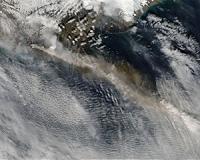 |
Columbus OH (SPX) Apr 14, 2011 Last year's $2 billion shutdown of European airspace following a volcanic eruption in Iceland alerted everyone to the danger that ash clouds can pose to aircraft engines. Now, researchers have discovered that a new class of ceramic coatings could offer jet engines special protection against volcanic ash damage in the future. For a study published online in the Early View edition of the journal Advanced Materials, the researchers tested two coatings that were originally developed to keep airborne sand from damaging jet engines, and found that the coatings also resist damage caused by ash deposits. "Of course, it's best for jets to avoid ash in the first place," said Nitin Padture, College of Engineering Distinguished Professor at the Ohio State University, who led the study. "That's not always possible. We determined that these coatings could offer sufficient protection against small amounts of ash ingested by the engine over time." However, large amounts of ash can temporarily jam a jet engine and cause it to stall, he explained. These coatings would not be useful in those extreme circumstances. Temperatures inside an engine reach up to 2,500 degrees Fahrenheit, and ceramic thermal-barrier coatings insulate metallic engine parts from that heat. The ingested ash melts onto the coating and penetrates the coating. Upon cooling, the molten ash forms a brittle glass that flakes off, taking the coating with it. It's a familiar story to Padture, who previously invented a new coating composition to prevent similar engine damage caused by sand. Like sand, ash is made mostly of silica. When the Icelandic volcano Eyjafjallajokull erupted in April 2010, it billowed clouds of silicate ash. "Ash poses a threat very similar to sand, but ash composition varies widely depending on the type of volcano. After what happened in Iceland, we wanted to see how ash interacted with our new thermal barrier coating, and whether the underlying damage mechanisms were any different," he said. Doctoral students Julie Drexler and Andrew Gledhill took samples of the ceramic coatings on pieces of metal, and coated them with ash from the Eyjafjallajokull eruption. Then they heated the samples in a furnace to simulate the high temperatures created in a jet engine. They experimented with a typical jet engine coating and two sand-resistant coatings. One was Padture's formula, containing zirconia and alumina, and the other was a commercially available new formula based on gadolinium zirconate. In that test, the ash badly damaged the typical coating, while coatings made of Padture's formula and the gadolinium zirconate formula retained their overall structure. Looking at cross-sections of the samples, the researchers saw why: molten ash had penetrated through the pores of the typical ceramic coating all the way to its base. But in the other two, the molten ash barely penetrated. Drexler explained why the pores are important. "Pores give the coating its strain tolerance," she said. "They make room for the coating to expand and contract as the engine heats up while flying, and as it cools after landing. When all the pores are plugged with ash, the coating can't adjust to the temperature anymore, and it breaks off." On the sand-resistant coatings, the ash filled the pores only near the surface. Chemical analysis revealed that the ash reacted with the alumina in the first coating to produce a thin layer of the mineral anorthite below the surface, while on the gadolinium zirconate it produced a layer of the mineral apatite. "The chemical reaction arrests the penetration of the ash into the coatings," Gledhill said. "The unaffected pores allow the coating to expand and contract." Now, the researchers are repeating their experiment with a new setup. They are heating samples over and over with a powerful blowtorch, and letting them cool in between to more closely simulate engine conditions. Both sand-resistant coatings are more expensive than the typical coating, but the researchers think that the benefits outweigh the cost. "This study's not going to solve all the problems of ash clouds and jet engines, but we are making progress, and we've learned a lot about the physics of the situation," Padture said. But that's not all they learned. "We also learned how to pronounce 'Eyjafjallajokull.'" Ohio State coauthors on the Advanced Materials paper included postdoctoral scholar Kongara Reddy. The engineers collaborated with Kentaro Shinoda and Sanjay Sampath of Stony Brook University and Alexander Vasiliev of the Russian Academy of Sciences. University of Iceland volcanologist Niels Oskarsson provided samples of Eyjafjallajokull ash.
Share This Article With Planet Earth
Related Links Ohio State University Aerospace News at SpaceMart.com
 Airline readiness for volcanic ash clouds tested
Airline readiness for volcanic ash clouds testedMontreal (AFP) April 13, 2011 One year after the eruption of Iceland's Eyjafjallajokull volcano, more than 70 airlines took part in a simulation on Wednesday to prepare for another ash cloud closing European airspace. The exercise simulated the eruption of the Grimsv�tn volcano in Iceland, sending volcanic ash south across the North Atlantic and Europe, said the International Civil Aviation Organization (ICAO), based in ... read more |
|
| The content herein, unless otherwise known to be public domain, are Copyright 1995-2010 - SpaceDaily. AFP and UPI Wire Stories are copyright Agence France-Presse and United Press International. ESA Portal Reports are copyright European Space Agency. All NASA sourced material is public domain. Additional copyrights may apply in whole or part to other bona fide parties. Advertising does not imply endorsement,agreement or approval of any opinions, statements or information provided by SpaceDaily on any Web page published or hosted by SpaceDaily. Privacy Statement |